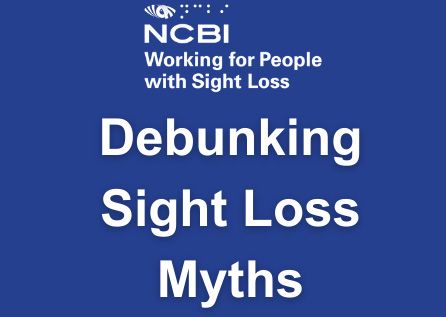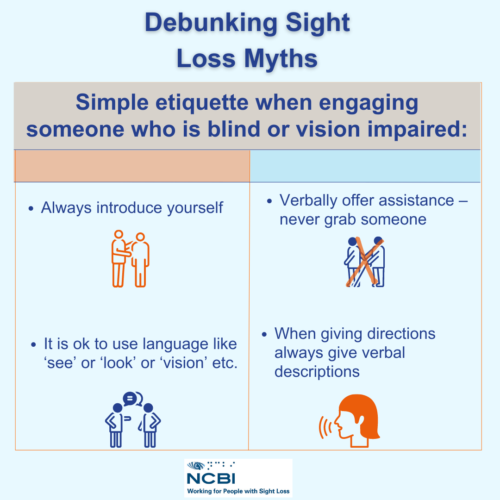

When engaging with a person who is blind or vision impaired, it is important to remember a few things to ensure that the person feels safe and respected throughout your interaction.
Simple points of etiquette when engaging with someone who is blind or vision impaired include:
-
- Always introduce yourself
- Verbally offer assistance – never grab someone
- When giving directions always give verbal descriptions
- It is ok to use language like ‘see’ or ‘look’ or ‘vision’ etc.
Always introduce yourself
When you first meet a person who is blind or vision impaired it is important that you introduce yourself fully. In some cases, people who have a vision impairment will be able to see you and recognise you if you have met before, but this obviously differs for each person depending on the individual factors which contribute to a person’s sight loss. Regardless, it is proper to still introduce yourself as you would in any other social interaction.
In situations where a person has low vision or is blind, they may be unable to see you so introducing yourself is incredibly important at the start of an interaction. It sets both sides up for a positive interaction and also shows that you are aware and mindful of the person’s experience with sight loss.
Verbally offer assistance – never grab someone
You should never be afraid to offer assistance to a person who is blind or vision impaired. If done in the correct way, people will often be grateful that you were on hand to help in situations which may be difficult for a person who has sight loss. Some people may politely decline your assistance if they are walking along a route that is well known to them, for example. Other people may accept your assistance in situations that may be dangerous, like crossing a big road, or when they are in unfamiliar surroundings.
Assistance can include helping to physically guide a person to their destination. While this requires that you touch a person who is blind or vision impaired, you should never just grab that person’s arm. The correct etiquette here is to ask a person if they need assistance, then ask them if they need to be guided. If they do need to be guided, you should offer your arm which the person who is blind or vision impaired can hold on their preferred side as you both walk.
When giving directions always give verbal descriptions
If you are offering assistance to, or physically guiding, a person who is blind or vision impaired, it is really important that you give verbal descriptions and instructions throughout the process. While guiding a person through the street, for example, you should always detail the obstacles around the person so they can avoid injury and navigate safely.
These instructions may include that you’re approaching a kerb which the person will have to step up onto when you instruct that they are close, for example. It may also include that there are obstacles like bins, bikes, cars etc that they will need to walk around. Be as descriptive as possible during this process so a person who is blind or vision impaired has a full picture of what is going on around them.
It is ok to use language like ‘see’ or ‘look’ or ‘vision’ etc.
It is important to remember that people who are blind or vision impaired are people just like anyone else and they should be spoken to as such. It is ok to use the language that you would normally use in a conversation. Using words like ‘see’, ‘look’ or ‘vision’ are often unavoidable in everyday conversation and you should not be conscious about using them once you’re using them in a way that doesn’t attempt to degrade the person you’re speaking to.